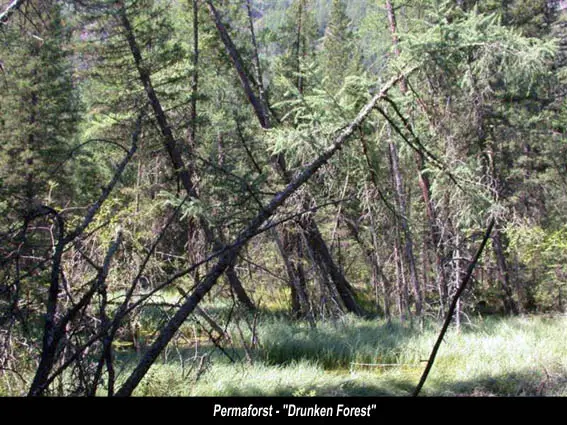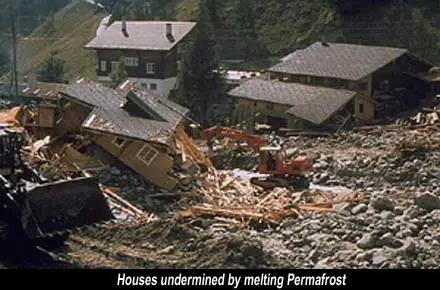Definition
Permafrost is any rock or soil material that has remained below 32° F (0° C) continuously for two or more years. The two-year minimum stipulation is meant to exclude from the definition the overlying ground surface layer that freezes every winter and thaws every summer (called the “active layer” or “seasonal frost”). This material underlies 12 to 18 percent of the exposed land surface in the Northern Hemisphere. Seasonally frozen ground regions may cover as much as 55 percent.
Exactly what is Permafrost?
Soil moisture content, overlying snow cover, or location does not define permafrost; it is defined solely by temperature. It can contain over 30 percent ice, or practically no ice at all. It can be overlain by several meters of snow, or little or no snow. Understanding permafrost is not only important to civil engineering and architecture, it is also a crucial part of studying global change and protecting the environment in cold regions (see also mountain permafrost ).
What is Happening?
The long-term records of the near-surface temperature, obtained from different parts of the permafrost zone in northern regions, show a significant warming trend during the last 30 years. Ground temperature trends generally follow the trends in the air temperatures with a more pronounced warming in the lower latitudes (between 55° and 65° North). This recent climate warming brought soil temperatures to a surprisingly high level, about 1 to 3°C warmer than long-term averages. Within some areas, temperatures are very close to 0°C and at some sites long-term degradation has already started. Areas of forest are now referred to as ‘drunken forests’, and as it melts the trees fall over.

Much of the Northern Hemisphere frozen ground is overlain by evergreen boreal forest. These boreal forests comprise both a source and a sink of carbon. In fact, the Arctic contains nearly one-third of the Earth’s stored soil carbon. So significant amounts of carbon are sequestered in perennially frozen soils (permafrost) and within the active layer, which thaw every summer but completely re-freeze during the following winter, where the organic matter decomposition is slow. That is why the majority of northern ecosystems are carbon sinks at present time. Climate warming and drying caused by this warming permafrost degradation will change this situation. A thicker, warmer and dryer active layer will activate microbes during the summer. Significantly later freeze-up of this layer in winter and warmer winter temperatures (that means much more unfrozen water in it) will considerably enhance the microbial activities during the winter.
So, the arctic and sub-arctic ecosystems are turning into a source of carbon dioxide, instead of storing carbon dioxide previously locked up in the permafrost. Further degradation and formation of taliks (an unfrozen section of ground found above, below, or within a layer of permafrost) will amplify these changes because microbial activities will then continue during the winter. In these areas of “wet thermokarst” formation, new and significant sources of methane will be developing.
Besides the dramatic impacts of sudden ground collapse and landslides, these swampy wetlands will release large quantities of methane, a greenhouse gas some 21 times more powerful than carbon dioxide. This has already been observed – during the unusually warm summers of 1987 and 1989, for example, methane emissions at observed sites on Alaska’s North Slope increased more than three times and two times respectively.
Sergei Kirpotin, a botanist at Tomsk State University in Russia reports that the the once-frozen peat bogs of Siberia – bigger than France and Germany combined – began to “boil” furiously in the summer of 2006 as methane bubbled to the surface.

Environment Canada warns, “The slow melting of the permafrost layer which underlies much of the Arctic tundra could turn the ground into a messy quagmire. This could affect northern transportation since in many areas surface travel is possible only when the ground is frozen solid.” In fact the number of days vehicles can use perma-roads each year has reduced from 225 days per year, to less than 25 days per year over the past 30 years. Buildings and other structures such as pipelines built directly on permafrost are becoming unstable as well, and sometimes causing landslides like that pictured above. Warming and Beetles – Anchor Point, Alaska
The social costs of higher temperatures have been mostly negative, and the Bush administration report, drafted by the Environmental Protection Agency (EPA), also found few positives to Alaska’s thermal rise. The government reported to the United nations, “There can no longer be any doubt that major changes in the climate have occurred in recent decades in the region, with visible and measurable consequences.” On the Kenai Peninsula, a forest nearly twice the size of Yellowstone National Park is in the last phases of a graphic death. Century-old spruce trees stand silvered and cinnamon-collared as they bleed sap. The spruce trees are dead or dying on the Kenai Peninsula from a huge increase in spruce bark beetles. In the past the beetles feeding on the evergreen trees don’t survive the winter, but populations have exploded as temperatures rise. Throughout the Kenai, people are clearing some of the 38 million dead trees, answering the call from officials to create a “defensible space” around houses for fire protection. Last year, two major fires occurred on this peninsula, and with temperatures in the 80s in mid-May this year, officials say fire is imminent. Ed Holsten of the Forest Service says it is just a matter of time before they have a very large, possibly catastrophic fire.
Conclusion
– Temperatures have increased during the last 20–30 years in almost all areas of the Northern Hemisphere. Warming of this ground mass is also reported from areas of mountain areas. This warming has not yet resulted in widespread thawing. Climate changes are projected to result in thawing across the subarctic by the end of this century, with the most significant thawing occurring in North America.
– The frozen ground stores a lot of carbon, with upper layers estimated to contain more organic carbon than is currently contained in the atmosphere. Thawing of this frozen ground results in the release of carbon in the form of greenhouse gases which will have a positive feedback effect to global warming.
– Thawing of this ice-rich land results in the formation of thermokarst, where parts of the ground surface have subsided. Thermokarst affects ecosystems and infrastructure and can accelerate thawing.
– The construction and everyday use of existing infrastructure can result in thawing, with subsequent effects on infrastructure. Increases in air temperatures may accelerate this ongoing degradation associated with infrastructure.
– Thawing of permafrost has significant impacts on ecosystems, with the potential to completely change habitats, for example, from boreal forest to wetlands. In mountainous areas thawing may increase slope instability, raising the risk of natural hazards such as landslides and rock falls.
